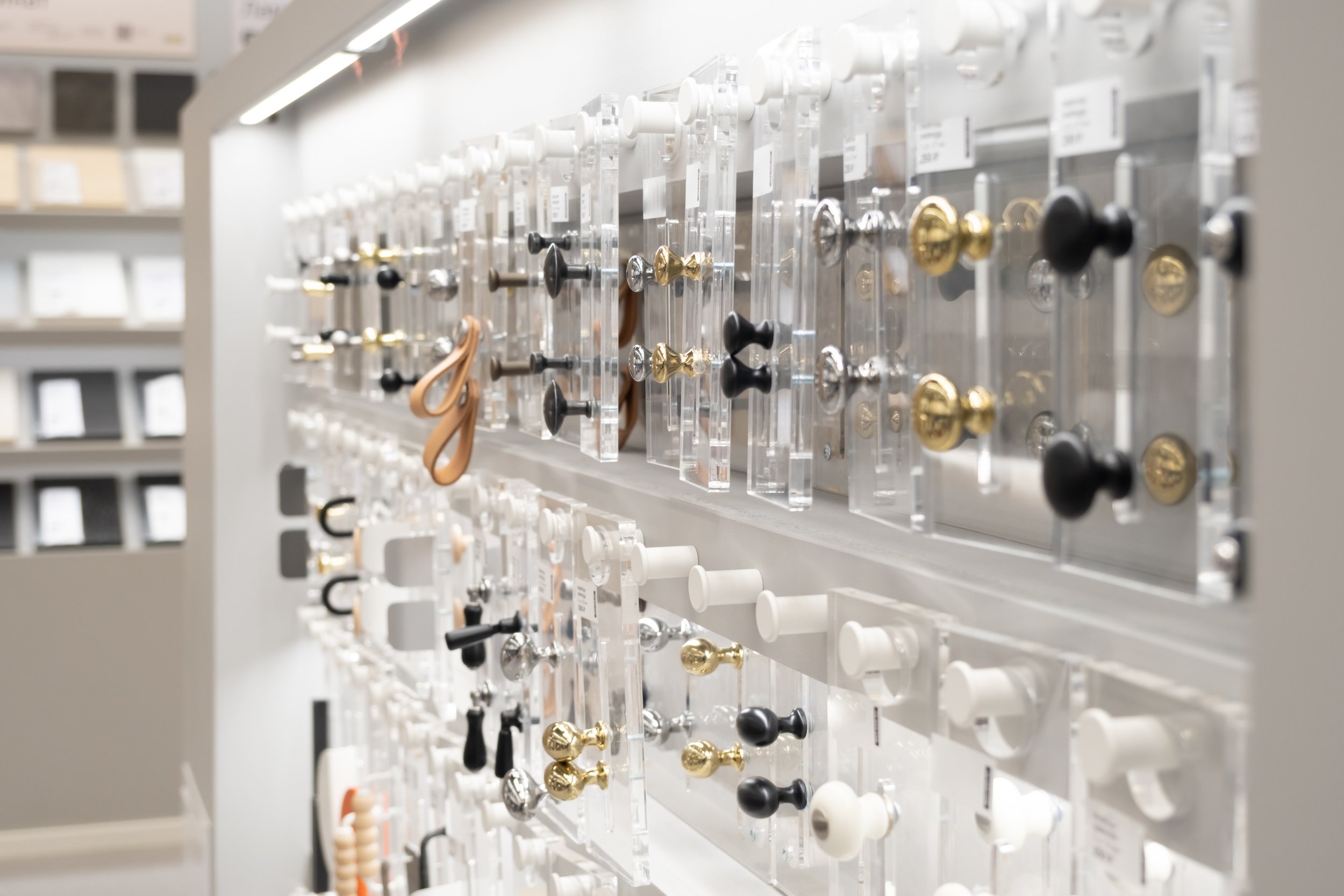Cabinet Hardware: Mastering the Art of Knobs, Handles, and Pulls
Selecting the right cabinet hardware is more than a mere afterthought; it's a crucial element in defining the aesthetic and functionality of your kitchen or bathroom. The knobs, handles, and pulls you choose can subtly enhance your space or make a bold statement. Here's an in-depth guide to navigating the world of cabinet hardware:
1. Consider the Style:
- Understanding Design Language: Begin by assessing the architectural and design style of your cabinets and the room. Traditional styles often pair well with ornate, classic hardware featuring curved lines and intricate patterns. On the other hand, contemporary or minimalistic cabinets call for sleek, streamlined hardware with clean lines and a modern feel.
- Historical Context: For homes with a specific historical context or theme, choosing hardware that reflects the era can add authenticity. Think brass pulls for a Victorian kitchen or minimalist chrome for a mid-century modern vibe.
- Mix and Match: Don't be afraid to experiment with contrasting styles. Sometimes, contemporary hardware can add a fresh twist to traditional cabinets, and vice versa.
2. Think About Functionality:
- Ergonomics in Design: Comfort in use is key. Knobs, typically round or square, are simple and effective for smaller drawers and doors. They are easy to install and can be a cost-effective way to update your cabinets.
- Pulls for Practicality: Handles or pulls are ideal for larger drawers and cabinets. They offer more space for a full-hand grip, making them practical for heavy drawers. Bar pulls, cup pulls, and bail pulls each offer a different aesthetic and hand feel.
- Accessibility Considerations: If you have accessibility concerns, look for hardware that is easier to grab and operate. Larger pulls or handles with a substantial grip area can be particularly beneficial for those with limited hand strength.
3. Coordinate with the Finish:
- Harmonizing with Your Palette: The finish of your hardware should complement not only your cabinets but also the wider color scheme of your room. Consider whether warm tones (like brass or bronze) or cool tones (such as chrome or nickel) would best suit your space.
- Consistency is Key: For a harmonious look, align the hardware finish with other metal elements in the room, like faucets, light fixtures, or appliance handles. This doesn't mean everything must match perfectly, but they should feel part of the same family.
- Trending Finishes: Be aware of current trends, but also think long-term. Matte black, brushed gold, and copper are trendy, but consider whether they will still appeal to you in the years to come.
4. Balance the Size:
- Proportional Aesthetics: The scale of the hardware in relation to your cabinets is crucial. Oversized handles on small drawers can dominate the design, while tiny knobs on large doors might look underwhelming. As a rule of thumb, hardware should be sized in proportion to the cabinet or drawer it's attached to.
- Visual Weight: Consider the visual weight of the hardware. Heavier, more substantial hardware can anchor large pieces of furniture or cabinetry, whereas lighter, smaller pieces might be more suitable for a delicate or minimalist design.
- Functional Consideration: Size also affects functionality. Larger hardware is generally easier to grip and use, an important aspect to consider in high-traffic areas like kitchens.
5. Try Different Shapes:
- Exploring Variety: The shape of your cabinet hardware can significantly impact the overall feel of the room. Round knobs offer a classic, timeless look, while square or rectangular shapes can provide a more modern or contemporary feel.
- Shape and Style Synergy: Shapes should complement the cabinet style. For instance, soft, curved lines of oval knobs can soften the look of angular, modern cabinets, while geometric shapes might enhance the structured feel of traditional designs.
- Unique and Unusual Shapes: Don't shy away from experimenting with unique or decorative designs. These can serve as statement pieces and add a touch of personality to your space.
6. Mix and Match:
- Eclectic Elegance: Mixing and matching hardware can give your space a dynamic, curated look. This approach works well in transitional spaces that blend elements from different styles.
- Consistent Variation: To maintain cohesion while mixing styles, stick to one aspect of consistency, be it the finish, material, or design element. For instance, using different shapes of hardware in the same finish can tie the look together.
- Room by Room Approach: Different hardware in different rooms (like the kitchen and bathroom) can define each space's unique character while maintaining a harmonious overall design. This approach allows you to explore varied design themes within the same home.
7. Test the Comfort:
- Hands-On Experience: The best way to gauge the comfort of cabinet hardware is by trying it out in person. This hands-on approach allows you to feel the grip, weight, and ease of use. Remember, what looks good might not always feel good, especially if you're using it multiple times a day.
- Ergonomic Design: Look for hardware that is ergonomically designed. This is particularly important in areas where you'll frequently be opening and closing doors or drawers. The hardware should fit comfortably in your hand and not require too much force to operate.
- Safety First: Ensure that the hardware does not have sharp edges or points that could catch clothing or injure someone, especially in a household with children.
8. Pay Attention to Materials:
- Material Matters: The material of your cabinet hardware affects both its appearance and durability. Popular options include brass, bronze, stainless steel, and even glass or ceramic. Each material offers a distinct look and feel, as well as varying degrees of durability and maintenance requirements.
- Complementing Your Cabinets: Choose a material that not only complements the style of your cabinets but also the overall theme of the room. For example, brass or bronze can add warmth to a space, while stainless steel or chrome provides a cooler tone.
- Longevity and Care: Consider the longevity and care requirements of each material. Some materials may tarnish or require more frequent cleaning to maintain their appearance.
9. Budget Considerations:
- Setting a Realistic Budget: Cabinet hardware prices can range from a few dollars to over a hundred dollars per piece. It's important to set a realistic budget that aligns with the overall cost of your kitchen or bathroom renovation.
- Cost vs. Quality: While it's tempting to cut costs on smaller items like cabinet hardware, remember that higher quality materials and finishes can offer better durability and longevity. Investing in good quality hardware can be cost-effective in the long run.
- Finding a Balance: Look for options that strike a balance between quality and affordability. Many mid-range brands offer stylish, durable hardware at reasonable prices. Keep an eye out for sales or bulk discounts, especially if you need a large quantity.
10. Easy Installation:
- Replacement Strategy: If you're updating existing hardware, a key tip is to select new pieces that match the existing hole spacing. This ensures a straightforward installation process without the need for drilling new holes.
- Hole Coverage: In cases where the new hardware doesn't match the hole spacing, look for styles that can cover any existing holes. This can save you from having to fill and paint old holes, simplifying the update process.
11. Personal Taste:
- Reflect Your Style: Above all, let your personal taste lead the way. Cabinet hardware offers a unique opportunity to inject your personality into your space. Whether you prefer classic elegance, modern minimalism, or eclectic charm, there's hardware out there that reflects your style.
- Experiment with Flair: Don't be afraid to take risks or try something new. Unlike more permanent aspects of your kitchen or bathroom, hardware can be easily switched out if your tastes change or you desire a different look in the future.
Concluding Thoughts: The Impact of Cabinet Hardware
In conclusion, the right cabinet hardware does more than just open a door or drawer; it plays a pivotal role in defining the character and functionality of your space. From considering the style, size, and shape, to balancing functionality with aesthetic appeal, each aspect of cabinet hardware selection contributes to the overall harmony of your home's design.
Remember, while trends may come and go, choosing hardware that resonates with your personal style ensures your space remains uniquely yours. And, with the flexibility to change hardware down the line, you can keep your space feeling fresh and updated with minimal effort.
By focusing on these aspects – style, functionality, material, budget, ease of installation, and personal taste – you're well-equipped to select cabinet hardware that not only looks great but also enhances the everyday use and enjoyment of your home. Let your cabinet hardware be the finishing touch that transforms your cabinets from mere storage solutions into integral, stylish elements of your home's design narrative.

